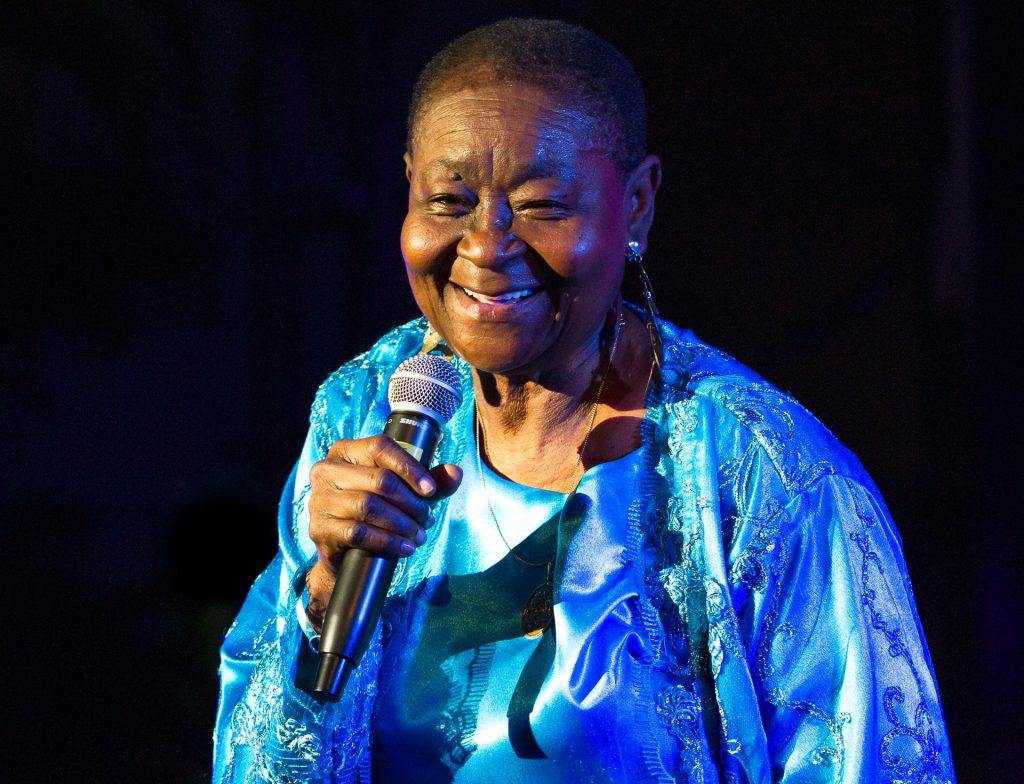In May of 2024, the jukebox musical on the life of pioneering female calypsonian Calypso Rose made its debut in Trinidad & Tobago. Queen of the Road: the Calypso Rose Story detailed her life and development over 40 calypsos, and — critically — showed the misogyny of rival calypsonians and a male-centred society that all but discarded many women in calypso.
Calypso Rose was a fighter — breaking rules, reversing tropes, and pioneering a space for future women on the stage and on the record. She paved the way for countless female calypsonians and soca artists. But first, a little history.
Today’s female calypsonians and soca artists descend from a long line of women who began their singing and carnival careers on the other side of polite society — the underclass below the diamètre (the French word from which the Patois “jammette” is derived).
The jammette underworld was dominant in Trinidad Carnival in the late 19th century — singers, drummers, dancers, stickfighters (both male and female), prostitutes and pimps, and more. The roll call includes unique characters with memorable names: Bodicia; Alice Sugar and her younger sister Piti Belle Lily; Cariso Jane; Mossie Millie; Ocean Lizzie; Sybil Steele; Ling Mama; Darling Dan; Hard Back Doris; Baje; Annie Coals and Myrtle the Turtle.
These women were the subject of early kaisos (the West African music from which calypso evolved, and a word sometimes used interchangeably with calypso) — getting name-checked in lyrics. For example, Cedric Le Blanc — the famous White chantwell (kaiso singer) — was reported singing in 1873:
Bodicea the diamette who we all know
Is a real disgrace to we cariso
I really can’t understand
Why she didn’t take the training of the Englishman.
Women’s influence and power were critical to calypso’s evolution in a male-dominated society. The 1882–1884 regulations and ordinances to ban Carnival activities made the men effectively go underground, suppressing their kalinda (stickfighting) songs.
The women were more direct — combative even — and continued their opposition to legal restrictions. They continued singing their carisos — smut-filled songs (part of calypso’s evolution) that also were full of humorous picong (taunting banter).
In 1883, a Trinidad newspaper described indecent songs as “imitations of the lewd songs of Curaçao, from which island they were first brought over and practised here by one BIMBIM and her equally vile daughters, who every night, to the peculiar music of their Quelbays (songs and dances), went through the most lascivious antics, indicative of the sensuous vocation to which they abandoned themselves.”
These chanterelles (female chantwells) became the foundation upon which the female calypsonians and modern female soca artists developed. Academics and researchers have posited and defended a thesis that the restrictions made by those ordinances showed that the male singers acquiesced, and ultimately appropriated the women’s less gladiatorial carisos as the new normal.
A kind of anodyne calypso evolved into the 20th century with men at the helm, effectively double entendre (double-meaning) and humour over aggression — man-of-words over man-of-war. It would not be far-fetched to suggest that without women there would be no modern calypso, and no soca without modern calypso.
The idea of women being sung about rather than being the singer took hold in the male-dominated calypso arena of the 20th century. Iconic calypsonian Atilla the Hun recorded the calypso “Deliso” in 1938, which included the stanza:
In those days women sang calypso
Like Sophie Mattaloney and Maribon
The used to walk about with boule-difé*
I mean, in the days of Canboulay.
(* a bottle of kerosene with a lit rag, similar to a Molotov cocktail)
That name — Sophie Mattaloney — pops up again in newspaper reports of the time as the singer of the Guadeloupean song “Estomac-li bas”, also called “Pauline”. It was considered by some experts as the most popular Carnival song of 1908, akin to a modern-day road march — a first for a woman.
History has her down as a “jammette matador” or, as the press had noted over several mentions, a “woman of the jammette world well known for ‘disturbing the peace’.”
Despite Mattaloney’s apparent pioneering achievement, misogyny and jealousy; the perverse degradation of menial or intimate quid pro quos; and a colonial Victorian social milieu that constrained island women to domestic roles — certainly not the calypso tent — collectively subjugated women’s careers, with their achievements in the arts over the first half of the 20th century only excavated by researchers and journalists years later.
In 1914, for example, unnamed women were part of the chorus singing with Julian Whiterose on the first calypso recording in English, and on original kalinda songs. Critically, a few women were made to become outliers — or, more accurately, pioneers.
Women’s influence and power were critical to calypso’s evolution in a male-dominated society
Lady Trinidad (Thelma Lane) was the first woman to perform in a tent as a featured act in 1935, and the first to record a calypso in 1937. An apocryphal story about rival calypsonians Roaring Lion and Atilla the Hun suggesting to businessman Eduardo Sa Gomes that Lady Trinidad was too attractive to visit the United States (US) to record and perform on radio without foreign men whisking her away in marriage denied her and the world another female calypsonian first.
Her pioneering moves led to baby steps: two more women entered the tent scene in 1936 — Lady Baldwin (Mavis Baldwin) and Lady MacDonald (Doris MacDonald). Lady Iere (Maureen St John) — first with her husband, Lord Iere, and later on her own — continued the slow march of solo female calypsonians over the next 20 years. However, the number of recordings of women over the next two decades is in doubt, as record masters were destroyed by Decca and others.
It wasn’t until the mid-to-late 1950s — when Calypso Rose (Linda McCartha Sandy-Lewis) entered the calypso tent, along with Singing Francine (Francine Edwards) — that there was incremental upward movement regarding female participation in the live and recording sectors of the industry.
Only in the intervening nearly three decades spanning Rose’s entry and her dual firsts for a woman in 1978 — winning the Calypso King competition (rechristened without gender as the Calypso Monarch) and the Road March crown, which was her second in consecutive years — did tents begin the inclusion of more women, though sadly still in low numbers.
Rose writing and performing her own songs should have inspired a new cohort, but male-penned calypsos still dominated songs sung by women.
The society in Trinidad had changed in the 21st century. Machismo was reluctantly dialled back for pragmatism, and when a woman was making strides, everybody got on board. Accolades were few yet seemingly not far between — a hopeful sign.
Singing Sandra (Sandra DeVignes-Millington) was the second woman to win the Calypso Monarch in 1999, and again in 2003 (making her the first to win twice). Her triumphs, along with Denyse Plummer’s (who won in 2001) showed minute progress at the turn of the new century. Karene Asche (2011) and Terri Lyons (2020) also won the Calypso Monarch. Nearly a decade passed between each of the last three wins.
Five winning women in over a century of calypso competitions repeats a pattern of indifference in calypso tents — but not on the road. Sanelle Dempster won the Road March in 1999 (the second by a woman), followed by three wins by Fay-Ann Lyons between 2003 and 2009; Patrice Roberts duetting to a win in 2006; and in 2010 the country elected its first female prime minister.
In the 50 years of soca becoming the de facto music of not just Trinidad Carnival, but carnivals across the Caribbean diaspora, there has been a marked difference both in participation and performance. Destra Garcia, Fay-Ann Lyons, Nadia Batson, and Barbadian Alison Hinds have been stars in the soca pantheon for decades, along with more recent superstars Patrice Roberts and Nailah Blackman. (All have been featured by Caribbean Beat, including cover stories on Batson, Hinds, and Calypso Rose.)
It would not be far-fetched to suggest that without women there would be no modern calypso, and no soca without modern calypso
They were writing their own songs and their performances, and, in a sense, reclaimed the attitude of the late 1800s jammette Carnival by owning their bodies and desires without the need for “mansplaining” experts preaching prudence; being defiant in the face of sectors looking to censor dance movements; and normalising what had been considered provocative. Female objectification in song continued, but some female singers were redefining it on record, on stage, and on their terms.
In 2004, calypso researcher Rudolph Ottley and his team founded the Divas Calypso Cabaret — an uncensored female voice in Trinidad Carnival — to provide an all-female cast as an alternative to the waning popularity of the modern calypso tent, and to provide a fillip for the still abhorrently low proportion of female calypsonians singing in established tents.
Two decades later, a man — Machel Montano — was the “attraction” at the Cabaret, ironically reflecting Lady Trinidad’s position from 1935.
Trinidad society has evolved, and with most masqueraders and steelpan players being women, it was inevitable that women’s participation in calypso followed an upward trajectory — almost 50% of casts in contemporary tents.
Women played a huge role in the development of calypso’s style and performance in the face of early banning ordinances, and in the return of a once-dominant Creole dance and performance aesthetic to the artform. Women in calypso is not a passing fad, but a lasting and successful reality.

